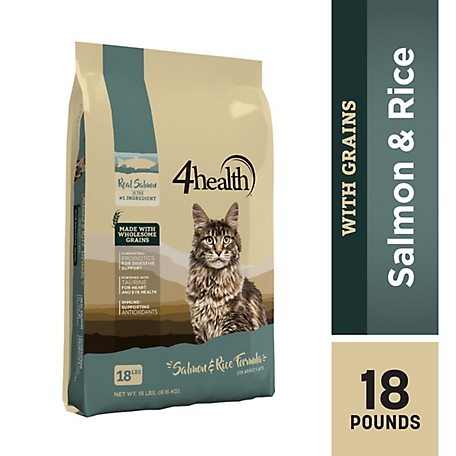4health with Wholesome Grains Adult Salmon and Rice Formula Dry Cat Food
Keep your cat healthy, happy and full with the 4health with Wholesome Grains Adult Salmon and Rice Formula Dry Cat Food. The wholesome, carefully selected ingredients provide optimal nutrition for adult cats of any breed. The kibble is made from real salmon and rice to deliver quality protein and mouthwatering flavor. In addition, all the essential vitamins and minerals – from taurine to omega fatty acids – are added. Probiotics in the cat food also help maintain the proper balance in your cat’s digestive system. Pick up a bag of 4health cat dog food today. Made in USA.
Keep your cat healthy, happy and full with the 4health with Wholesome Grains Adult Salmon and Rice Formula Dry Cat Food. The wholesome, carefully selected ingredients provide optimal nutrition for adult cats of any breed. The kibble is made from real salmon and rice to deliver quality protein and mouthwatering flavor. In addition, all the essential vitamins and minerals – from taurine to omega fatty acids – are added. Probiotics in the cat food also help maintain the proper balance in your cat’s digestive system. Pick up a bag of 4health cat dog food today. Made in USA.
- Meets the nutritional needs of adult cats
- Made with real salmon and wholesome grains for optimal diet
- Formulated with select ingredients and underwent rigorous quality control processes
- Fortified with taurine to support heart health and eye health
- Blend of omega-6 and omega-3 fatty acids helps keep the skin and coat healthy and shiny
- Probiotics help maintain the proper balance in your cat’s digestive system; each cup of dry cat food provides live, active cultures that help support healthy digestion
- Contains guaranteed levels of zinc, selenium and vitamin E for immune-supporting antioxidant nutrition
- Salmon and rice flavor attracts most cats
- Made in USA
- Cat food comes in several different size bags to choose from
- Formulated to meet the nutritional levels established by the AAFCO Cat Food Nutrient Profiles for maintenance
Additional information
| Country of Origin | Made in USA |
|---|---|
| Breed Size | Extra Small, Small, Medium, Large, Extra Large |
| Flavor | Salmon and Rice |
| Life Stage | Adult |
| Primary Flavor | Rice, Salmon |
| Packaged Height | 24 in. |
| Packaged Length | 4 in. |
| Packaged Width | 15 in. |
| Manufacturer Part Number | 9821 |










by Fay
Our dogs stay healthy, and love the flavor. No more skin allergies or ear infections.
by Sarah
My cats love it. I feed my cats and dogs 4Health brand. They don’t like anything else
by Harry
Bought it for my indoor cat he loves it.
by Smith
Cat’s love it.